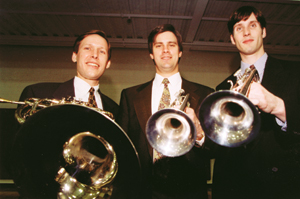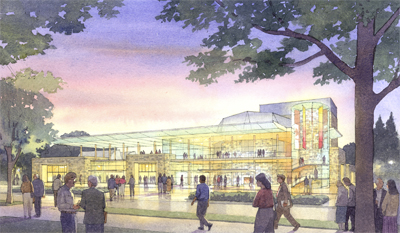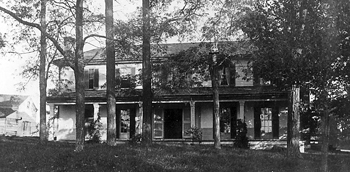 An outlet for creativity: The arts on campus An outlet for creativity: The arts on campus
by Jennifer Henderson |
|
|
|
|
|
"There's a type of brain that comes with the ability to invent--a highly analytical one," says Kevin Dunetz (electrical engineering '89). "Music provides a balance for that analytical side and an outlet for creativity." David C. Welch (industrial and systems engineering '91) agrees, noting, "I think a lot of engineers on campus feel the same way."
As students, Dunetz, who plays trumpet, and Welch, who plays French horn, were members of the Quintessential Brass Repertoire, the brass quintet that Welch founded at Virginia Tech in 1988. "I wouldn't have come to Tech if there hadn't been a music program; if Allen Bachelder hadn't been a trumpet teacher here," Dunetz adds.
|
|
|
|
That Tech touch |
|
|
|
Kevin Dunetz '89 says that when he decided to start a telecom expense management software company, he wanted founding partners with certain skill sets. "Namely trust--a belief in each other and what you're doing," he says. It's telling, then, that today, 15 percent of Rivermine's workforce is comprised of Hokies. The company has secured tens of millions in venture funding and is ranked the eighth-fastest growing technology company in Virginia by Deloitte & Touche. |
|
|
|
 |
|
|
|
 In October 1998, David Welch '91 (left) and Kevin Dunetz '90 (right) returned to campus to perform during the dedication of McComas Hall. Charles Peterson '91 (middle) is another original member of the Quintessential Brass Repertoire. In October 1998, David Welch '91 (left) and Kevin Dunetz '90 (right) returned to campus to perform during the dedication of McComas Hall. Charles Peterson '91 (middle) is another original member of the Quintessential Brass Repertoire. |
|
|
|
The pair's professional success may prove their theory about the need for a creative outlet: In 2001, Dunetz and Welch--along with mutual friend Doug Rutherford--co-founded Rivermine, a company whose software and services have saved many Fortune 1000 companies and government agencies millions of dollars per year.
Welch and Dunetz are representative of the many alumni who believe that the arts are an integral part of Virginia Tech, including one highly visible alum, President Charles W. Steger (architecture '69). During Steger's inaugural address, he announced plans to create a fine and performing arts center on campus, stressing that the study of the arts is important because an institution of higher education must always strive to educate the whole person. "We owe the student more than a preparation for life at work," Steger noted. "We owe students the opportunity and means to educate themselves beyond work and after work."
That alumni embrace this sentiment is evident from gifts made by such donors as Bruce C. Carver (finance/business '83), CIO for Dana Corporation in Toledo, Ohio, who recently gave $250,000 to create the Bruce C. Carver Multicultural Fund to support diversity in the arts. Or from the pledge by Tom Ackiss (architecture '64) that provides for unrestricted planning and programming funds. "As an architecture student, I had one foot planted in the arts and the other in engineering," Ackiss notes. "They are complementary disciplines driven by creativity, invention, and expression. It's this connection that enables us to stand in awe of a great building, to be touched by a great painting, or to be moved by great music."
It's obvious that Welch and Dunetz feel the same--when looking back at their time at Tech, they say, their best memories are of playing music here. That's one reason Welch created the James D. McComas Student Chamber Music Ensemble Fund in 1998 and established a bequest to benefit the fund in 2004. Welch wanted to honor the former university president, whom he credits with making a difference in the quality of his experience at Virginia Tech. "Dr. McComas and his wife, Adele, were so great about helping our brass quintet," he recalls. "They'd hire us for gigs, rent us a van, that sort of thing."
A T. Marshall Hahn Scholarship recipient, Welch firmly believes in the importance of giving back. "It's an obligation--a good one," he says.
|
| Concept sketch of the proposed Center for the Arts |
In 2006, President Charles Steger appointed Minnis E. Ridenour as chair of a special arts stakeholders' group to guide programmatic planning for the Center for the Arts and related arts initiatives. Ridenour, former executive vice president and chief operating officer of Virginia Tech, is providing leadership to the fundraising efforts for the $20 million in private funds needed to construct this $50 million facility. Kylie Johnson, director of development for the arts, says, "Minnis' leadership is invaluable as we work to make the Center for the Arts a reality. This is a transformative project."
|
 |
|
These gifts illustrate that alumni of all majors are interested in seeing Virginia Tech develop a stronger arts presence on campus. They also signal a hopeful future for the Center for the Arts as a centerpiece of a larger university plan that will increase access to the arts and encourage more participation by students, faculty members, and the greater region.
At a university so highly esteemed for its analytical education, the arts are a vital way to provide balance and offer an outlet for creativity to an entire community.
|
|
|
 Jennifer Henderson is a writer for the Office of University Development. Jennifer Henderson is a writer for the Office of University Development. |
|
 New life for a place of Solitude New life for a place of Solitude
by Alexandria Marder and Amy Boyce M.A. '97
 |
|
If you're like many alumni who have strolled the paths beside the Duck Pond and admired the tranquil setting, you've probably given little thought to the old white farmhouse on the shore. In fact, this historic structure represents Virginia Tech's past, as well as a link to its future. The old farmhouse is now being readied for a new life as the university works to restore Solitude to its mid–to-late-19th-century appearance and establish a multi–use Appalachian Center on the site.
Before that can occur, however, much work must be done to counteract years of deferred maintenance and insensitive alterations. Although some initial work on historic documentation and site preparation has been accomplished, limited financial resources have slowed the project's progress.
|
|
|
|
| Often referred to as our "home place," Solitude is the university's oldest building, added to the National Register of Historic Places in 1989. Built in 1801 for James Patton Preston, Solitude was later the home of two Virginia governors, John Floyd and John Buchanan Floyd, and of James Preston's son and daughter–in–law, Robert and Mary, who enlarged the house in Greek Revival style around 1859. |
 |
| Acquired in 1872 to augment the property needed by Virginia Tech, Solitude has served in various capacities throughout the years: as faculty housing, a clubhouse for returning veterans attending the school, apartments, the site of the Hokie Club alumni organization, and an academic building. |
|
|
Enter the Mary Morton Parsons Foundation.
Based in Richmond, Va., the foundation has a long history of supporting arts and cultural, civic, and community needs; education; social services; and historic preservation. On learning of Solitude's rich historical and architectural heritage and the university's plan to rehabilitate and protect the structure, the foundation stepped in to help. Issuing a challenge to the university community to meet them in the middle, foundation trustees have awarded a grant of $500,000 to assist with the building's restoration, payable when Virginia Tech has raised an additional $500,000 from other sources.
Alumni, friends, and other corporate and foundation resources can help the university meet--and even exceed--the challenge and see this important restoration effort through to completion. Solitude will transform into the Appalachian Center, serving as a focal point for studies related to Virginia's mountain region and providing an historic venue for demonstrations of regional arts and culture, educational tours, workshops, and other university events. With your help, Solitude will once again reflect the rural mountains and the world as it was in the 19th century, while showcasing the dynamic atmosphere of the university today.
If you would like to help meet the challenge set forth by the Mary Morton Parsons Foundation, please contact the Office of University Development at 800/533-1144.
 Amy Boyce is publications editor and Alexandria Marder is special projects editor; both work for the Office of University Development. Amy Boyce is publications editor and Alexandria Marder is special projects editor; both work for the Office of University Development.
|
|

